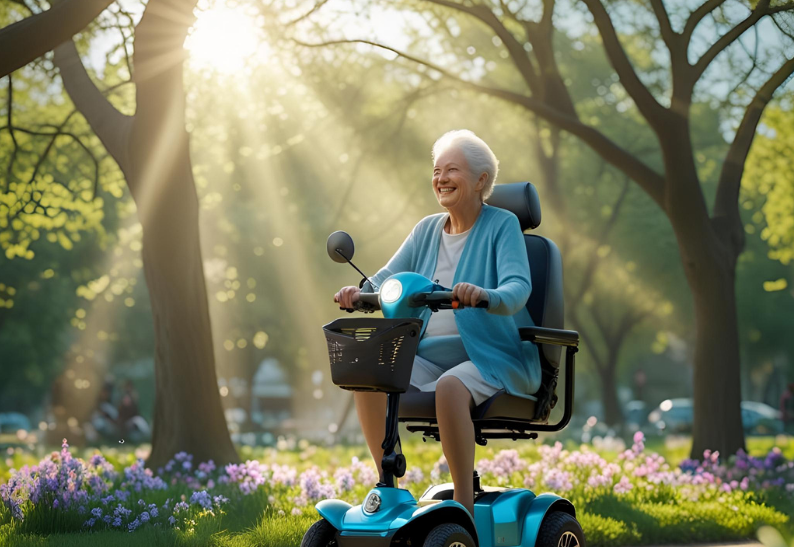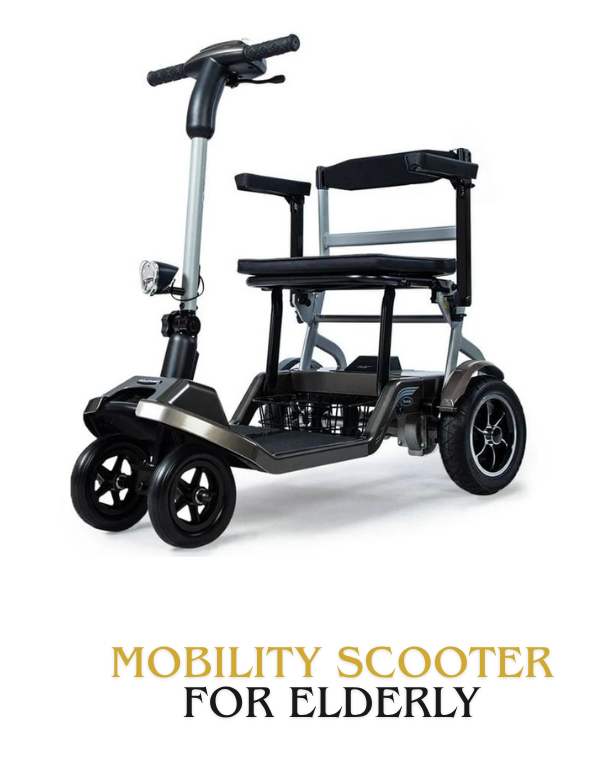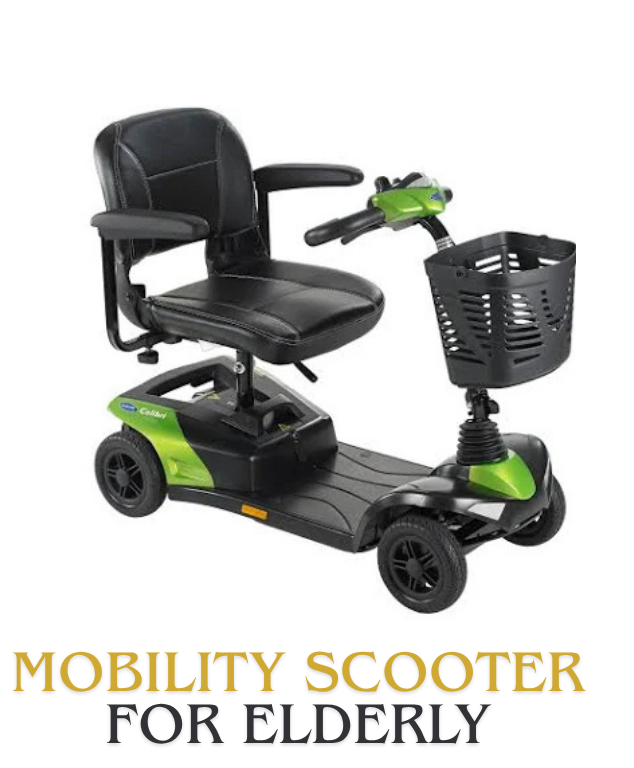- Home
- Adult Mobility Scooter
- Mobility Scooters for Elderly
Mobility Scooters for Elderly: Rolling Toward Independence
Mobility scooters for elderly individuals are more than just convenient transport. They’re freedom on wheels- gateway to independence, adventure, and comfort. If you or a loved one struggles with walking long distances, arthritis, or mobility challenges, these nifty little vehicles can be life-changing.
No more missing out on grocery runs, park visits, or family outings. With the right scooter, the world opens up again! The impact goes beyond convenience—it’s about comfort, dignity, and joy.
But with so many options, how do you pick the best mobility scooter for elderly one? Don’t worry—we’ll break it all down in simple terms.
This guide keeps things light, practical, and easy to follow. You’ll find the ins and outs of elderly mobility scooters, from types and features to safety tips and clever add-ons.
No fluff, no brand bias—just helpful info delivered with a smile.

What Is a Mobility Scooter—and Why It Matter
At its core, a mobility scooter is a battery-powered assistive device that helps people with limited mobility move more freely. Unlike wheelchairs, scooters don’t require manual strength and often offer more comfort, better range, and more independence.
A mobility scooters for elderly users typically come with:
- A seat on wheels — comfy and adjustable
- Tiller steering — intuitive controls for easy navigation
- Rechargeable battery — power that gets you from point A to B (and back again)
- Sturdy frame and wheels — safe on different surfaces like footpaths, shops, or gardens
Whether it's to get from the living room to the local café or to explore a holiday market, this vehicle rolls with you—not against you.
Who Can Benefit Most from a Mobility Scooter?
Mobility scooters can be life-changing for a wide range of people. They’re especially beneficial for seniors who experience reduced strength, stamina, or balance, helping them stay active and involved.
Individuals living with mobility-limiting conditions like arthritis, Parkinson’s, or multiple sclerosis also find scooters invaluable in reducing strain and increasing their range.
Beyond direct users, therapists and care providers often turn to scooters as tools that support patient independence and rehabilitation.
And for families, mobility scooters for elderly offer a way to help elderly loved ones remain connected, confident, and present in everyday life. At its core, a scooter is more than a mobility aid — it’s a bridge between staying home and staying social.
Not just practical, but truly empowering.
Types of Mobility Scooters for Elderly Users
Not all mobility scooters are the same. Here’s a quick guide to the main types:
1. Travel/Portable Scooters
- Lightweight & foldable (great for car trunks).
- Smaller batteries = shorter range (good for quick errands).
- Best for those who need occasional mobility help.
2. Mid-Size Scooters
- Balance of power and portability.
- Better range (10-15 miles per charge).
- Ideal for daily use around town.
3. Heavy-Duty Scooters
- Larger, sturdier, with higher weight capacity.
- Long-range batteries (up to 30 miles!).
- Perfect for outdoor adventures and rough terrain.
4. 3 Wheel
- Indoor mobility, tight spaces
- Easier turning radius
5. 4 Wheel
- Outdoor use, extra stability
- Balanced performance and comfort
Not sure which one suits best? Start with your routine: Do you need indoor turning ease or outdoor strength?
Features That Make a Difference for Mobility Scooters for Elderly
A mobility scooter isn’t a one-size-fits-all machine. Here’s what to check before buying or renting:
1. 🪑 Comfort & Seating
- Swivel seat for easy on/off without hip strain
- High-back seating for posture support
- Adjustable armrests and padded cushions for longer trips
2. 🔋 Battery Life
- Look for 10–30 km per charge depending on your outings
- Removable batteries make for easy charging indoors
- Lithium-ion = lighter, longer-lasting
3. 🎮 Control & Navigation
- Ergonomic tillers reduce wrist strain
- Speed limiters help maintain safe indoor/outdoor paces
- Tight turning radius for crowded stores or hallways
4. 🛞 Wheels & Suspension
- Pneumatic tires handle bumps like a champ
- Solid tires mean less maintenance
- Built-in suspension = smooth rides on uneven paths
5. 🧳 Portability
- Can you fold it? Disassemble it? Lift it into the boot?
- Lighter models weigh around 20–30 kg, ideal for travel
- Larger ones may need a ramp or car carrier

Safety Features Seniors (and Families) Love
These features don’t just protect the rider—they also give peace of mind to family members and caregivers. After all, independence should never come at the cost of safety.
With these smart design elements, seniors can scoot confidently, knowing they’re well-equipped for the ride.
Real Talk: Pros and Cons
Mobility scooters for elderly come with a lot of upside.
For starters, they’re fantastic at boosting independence and self-esteem. They allow users to participate more fully in daily life, whether it’s heading to the shops, visiting friends, or just enjoying a sunny stroll.
By reducing physical strain and the risk of falls, they offer both peace of mind and physical freedom. Many portable models are also designed with spontaneity in mind, folding up neatly for travel. Plus, their versatility makes them ideal for navigating both indoor and outdoor spaces with ease.
That said, there are some practical considerations. The initial cost can be a hurdle, though rental options are increasingly available. Scooters also require a dedicated place to store and charge, which might be a challenge in smaller homes or apartments.
Not all models are easy to lift or transport without help, especially the heavier-duty designs. Still, when well-matched to the user’s needs, a scooter shouldn’t feel like a burden — it should feel like an extension of one’s freedom.
Appearance & Aesthetic
Gone are the days of bulky, clinical-looking scooters. Today’s models are stylish and full of flair, with options that suit both taste and personality.
Whether you prefer sleek charcoal or a bold cherry red, there’s a colour and style to match. Some come fitted with basket attachments or hidden under-seat storage, while others boast padded, leather-look finishes for a touch of luxe.
Modern scooters even feature LED display panels for battery level, speed, and turn indicators — proof that functionality and good looks can roll hand-in-hand.
Optional Add-ons to Consider
Want to make your scooter truly yours?There’s a wide range of add-ons that can enhance comfort and practicality.
Weatherproof canopies offer shade or protection during sudden downpours, while rear baskets and oxygen holders add accessible storage and support for medical needs. Some mobility scooters for elderly models include USB ports to keep your phone charged on the go.
Accessories like walking stick holders and cup holders (because yes, your morning flat white deserves a secure spot) may seem small, but they make a big difference in everyday usability. And often, they come at minimal extra cost — small upgrades, big payoffs.
Before You
Buy: Smart Shopper Tips
Make an informed choice with these quick checks:
- Measure the doorway, lift, or hallway at home
- Ask if the scooter fits in your car (folded or disassembled)
- Check weight capacity (usually 120–180 kg)
- Request a test ride or demo from a local supplier
- Look into local service and support options
- Confirm return and warranty policies—because life happens
Safety Tips for Scooting Like a Pro
Even the best mobility scooters for elderly needs a responsible driver. Follow these tips:
- Practice First – Get comfortable in an open space before hitting busy areas.
- Watch for Obstacles – Curbs, potholes, and steep slopes can be tricky.
- Stay Visible – Use lights and reflective strips if out at dusk.
- Regular Maintenance – Check tires, brakes, and battery life often.

Wrap-Up:
Why It’s Worth It
Mobility scooters for elderly users aren’t simply gadgets—they’re essential enablers. They help regain control, maintain social lives, and reduce the risk of injuries from over exertion or falls.
✅ They fold.
✅ They glide smoothly.
✅ They boost confidence.
✅ They put control back where it belongs—into the hands of the user.
Your next outing, appointment, or picnic in the park? A mobility scooter can get you there.
It’s not just transportation—it’s liberation with handlebars.
Back to top. / Back to Adult Mobility Scooter/Back to Homepage



